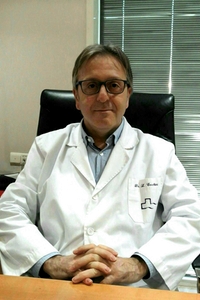

 Centro Médico Teknonen/health-centers/centro-medico-teknon
Centro Médico Teknonen/health-centers/centro-medico-teknon Centro Médico Teknonen/health-centers/centro-medico-teknon
Centro Médico Teknonen/health-centers/centro-medico-teknon
- What is laparoscopy?
It is the technique that allows to undergo surgical procedures from outside of the abdominal cavity introducing the instruments through small orifices, without needing an open wound to reach the location of the surgery.
By means of a gas insuflator (CO2) the abdominal cavity is expanded allowing the space necessary to introduce the different surgical instruments. The procedures are visualized through a scope attached to a video camera connected to a TV monitor.
- How is laparoscopic surgery done?

Instruments are introduced through some tubes (trocars) that are set through the skin. The number of these trocars will depend on the surgery complexity.
There are several instruments to work through these ports equivalent to open surgery ones and others specifically designed for laparoscopy.
 All this intrumentation is in constant evolution with continuous new versions appearing,allowing for improvement in the different surgical techniques. This fact has led to new surgeries by a laparoscopic approach not feasible some years ago.
All this intrumentation is in constant evolution with continuous new versions appearing,allowing for improvement in the different surgical techniques. This fact has led to new surgeries by a laparoscopic approach not feasible some years ago. - ¿Qué ventajas supone sobre la cirugía convencional?
La cirugía laparoscópica tiene una serie de ventajas:
1. Una recuperación más rápida y sin grandes heridas.El hecho de que la incisión de la piel y musculatura sea mucho más pequeña (sólo para colocar los trócares) hace que la recuperación sea mucho más rápida y sin grandes heridas.
2. La pérdida de sangre es casi nula.La necesidad de trasfusiones de sangre es muy baja. Eso se debe a diversos factores: la propia presión de gas del insuflador evita buena parte del sangrado venoso y para mantener una buena visión es necesario un gran control del sangrado.
3. La precisión con lesión interna mínima.La magnificación de la imagen a través de una cámara de alta tecnología que ofrece el sistema de vídeo permite la realización de la técnica quirúrgica con gran detalle anatómico y precisión y con la mínima lesión interna.
- How did laparoscopy start?
Surgical approaches by means of external instruments exist since the last century with the development of the first cystoscope (instrument introduced through the urethra to examine the inside of the bladder). Since then endoscopic surgery in Urology has evolved, allowing procedures through the urethra (transurethral), the urethers (transuretheral) and of the kidney from the exterior (percutaneous). Other specialties as Gynecology or Digestive Surgery have developed their own techniques.
- How did it start in Spain?
In Spain first laparoscopic radical prostatectomy was undergone in 2002 in the Hospital Universitari Germans Trias i Pujol of Badalona by the team of Drs. Saladié, Cecchini and Areal, with the collaboration of Dr. Nicolas Roques from Perpignan (France).
Since that moment, Dr. Cecchini has been practicing this and other laparoscopically approach procedures in his hospital, in private practice as well as in live surgery venues across Spain. Today many centers in Spain do lap surgery partly thanks to the divulgation and teaching done by some pioneers, Dr. Cecchini among them.



































